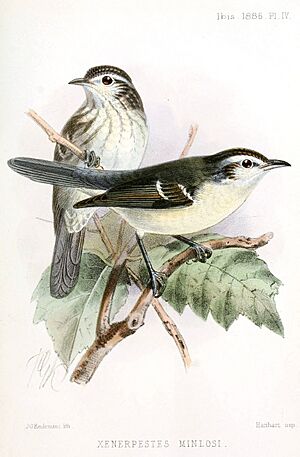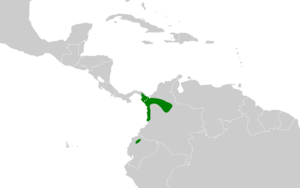Double-banded greytail facts for kids
Quick facts for kids Double-banded greytail |
|
|---|---|
 |
|
| Conservation status | |
| Scientific classification | |
| Genus: |
Xenerpestes
|
| Species: |
minlosi
|
 |
|
The double-banded greytail (Xenerpestes minlosi) is a small bird that belongs to the ovenbird family called Furnariidae. It's found in Colombia, Ecuador, and Panama. It gets its name from the two white bars on its wings, which look like bands!
Contents
About the Double-banded Greytail Family
The double-banded greytail has two main types, called subspecies. Think of subspecies as slightly different versions of the same animal, often living in different places. These are X. m. minlosi and X. m. umbraticus.
This bird is related to the equatorial greytail (X. singularis). They are like close cousins in the bird world. They are also related to the orange-fronted plushcrown (Metopothrix aurantiaca).
What Does It Look Like?
The double-banded greytail is a tiny bird, only about 11 to 12 centimeters (4.3 to 4.7 inches) long. That's about the length of a pen! It looks a bit like a warbler. Both male and female birds look the same.
Adult birds have a grayish face with a creamy white stripe above their eye. They have a dark gray line behind the eye. Their head, back, and tail are dark gray. Their wings are also dark gray, but they have bright yellowish spots near the body and two white bars. These white bars are where the "double-banded" part of their name comes from!
Their throat and belly are a creamy white color. Their eyes are light brown. Their beak is dark brown on top and grayish-white underneath. Their legs and feet are grayish-brown. Young birds look similar but have less clear markings.
Where Does It Live?
The double-banded greytail lives in different parts of South and Central America.
Nominate Subspecies Location
The X. m. minlosi subspecies is found in Colombia. It lives near the Caribbean coast and in the Magdalena River Valley. You can find it as far south as the Boyacá and Santander areas.
Umbraticus Subspecies Location
The X. m. umbraticus subspecies lives in eastern Panama in the Darién Province. It also lives in western Colombia and goes south into northwestern Ecuador. In Ecuador, it's found in the Esmeraldas and Pichincha provinces. It's quite rare in Ecuador.
Habitat Preferences
This bird likes to live in lowland and foothill evergreen forests. It can be found in both old, untouched forests and mature forests that have grown back. It usually lives from sea level up to about 900 meters (3,000 feet) high. In Ecuador, it stays a bit lower, usually around 500 meters (1,600 feet).
How Does It Behave?
Movement and Home
The double-banded greytail stays in the same area all year round. It doesn't migrate to other places.
What Does It Eat?
This bird mainly eats arthropods, which are creatures like insects and spiders. It usually looks for food alone or with one other bird. It often joins mixed-species feeding flocks. These are groups of different bird species that forage together. This can help them find more food or stay safer from predators.
The greytail searches for food from the middle part of the forest all the way up to the treetops. It especially likes dense areas with lots of vines. It picks prey off leaves, even hanging upside down to reach the underside of leaves! It also finds food on twigs and sometimes on flowers.
Breeding Habits
Scientists don't know much about how the double-banded greytail builds nests or raises its young. More research is needed to learn about its breeding habits.
What Does It Sound Like?
The double-banded greytail has a unique song. It's described as a "long, dry, extremely rapid chattering trill." It stays on the same pitch but gets louder. Its call is a "sharp, thin, inflected note."
Is It Endangered?
The IUCN (International Union for Conservation of Nature) has looked at the double-banded greytail. They have assessed it as being of Least Concern. This means it's not considered to be in danger of extinction right now.
The bird lives in a large area. Scientists estimate there are at least 50,000 adult birds, but this number might be slowly going down. No major threats have been found for this bird. It's thought to be rare in some places, but this might be because it's a hard bird to spot!


